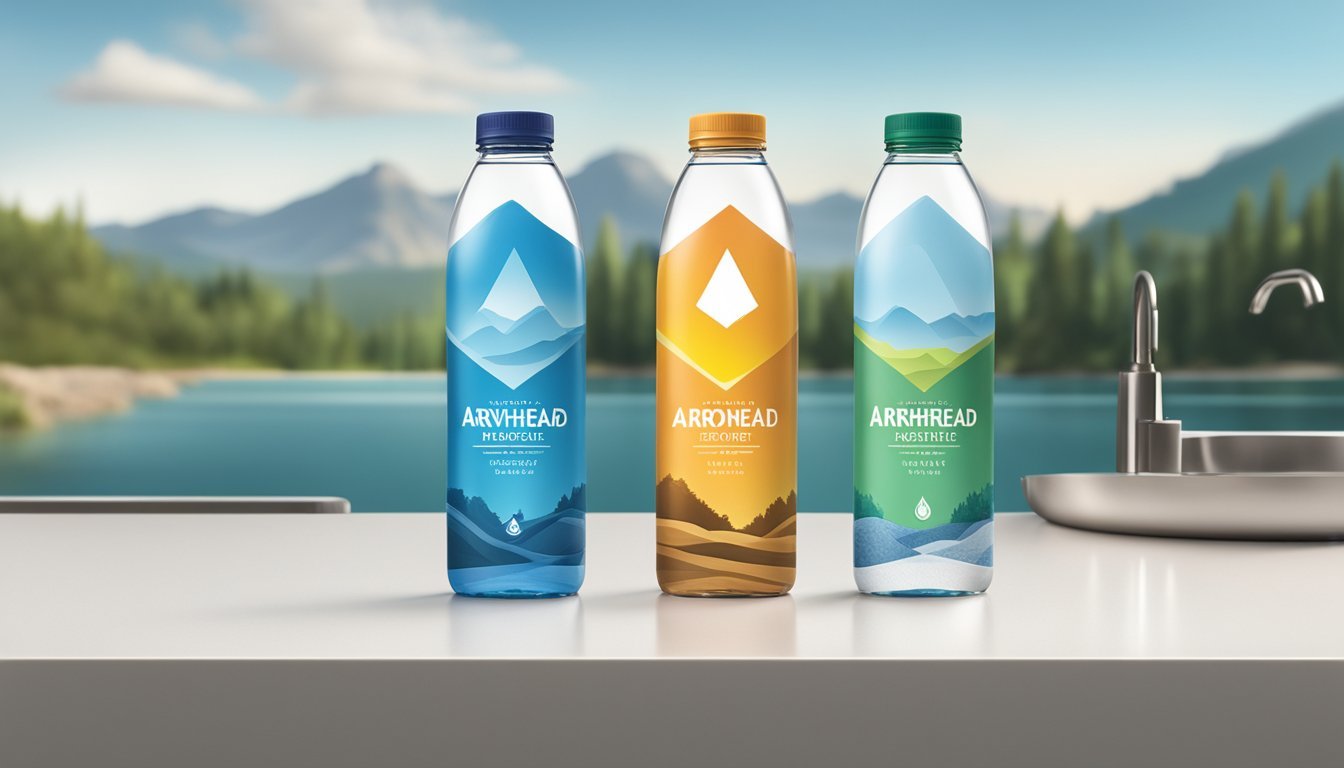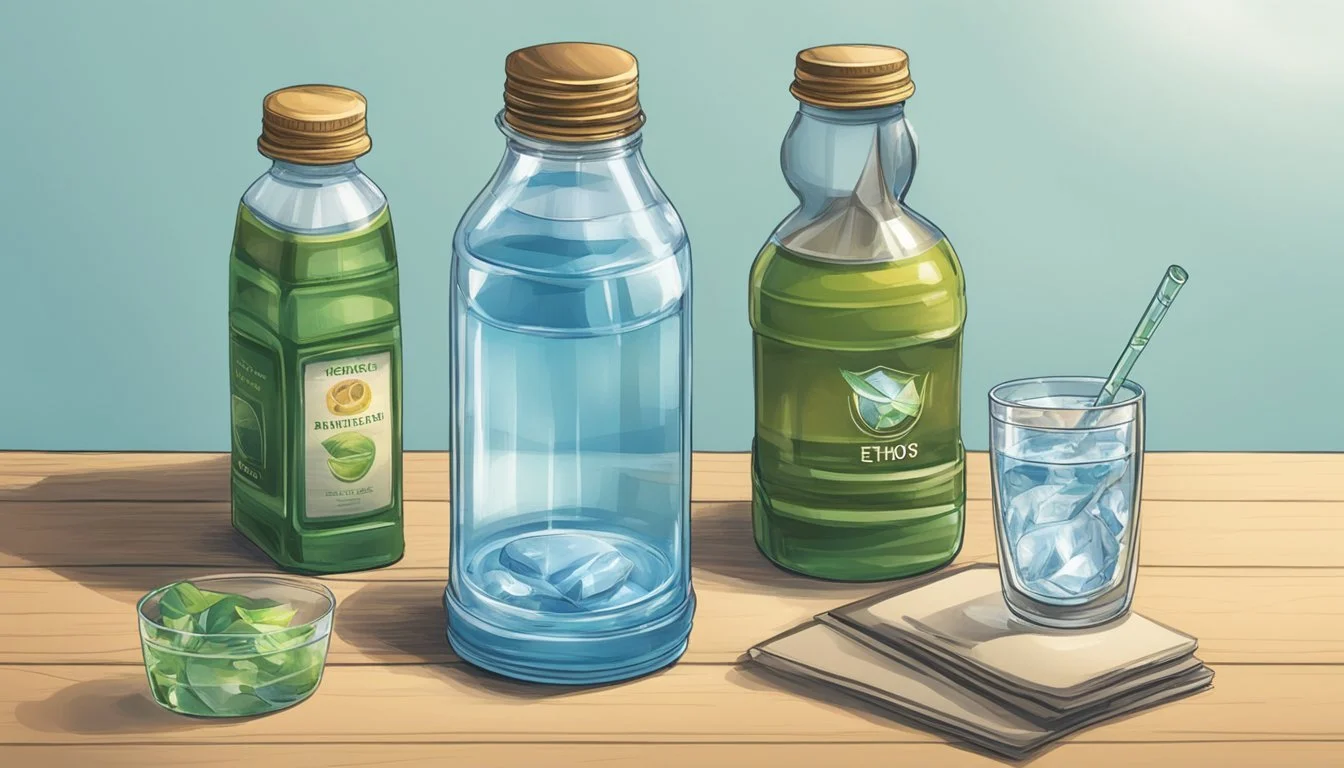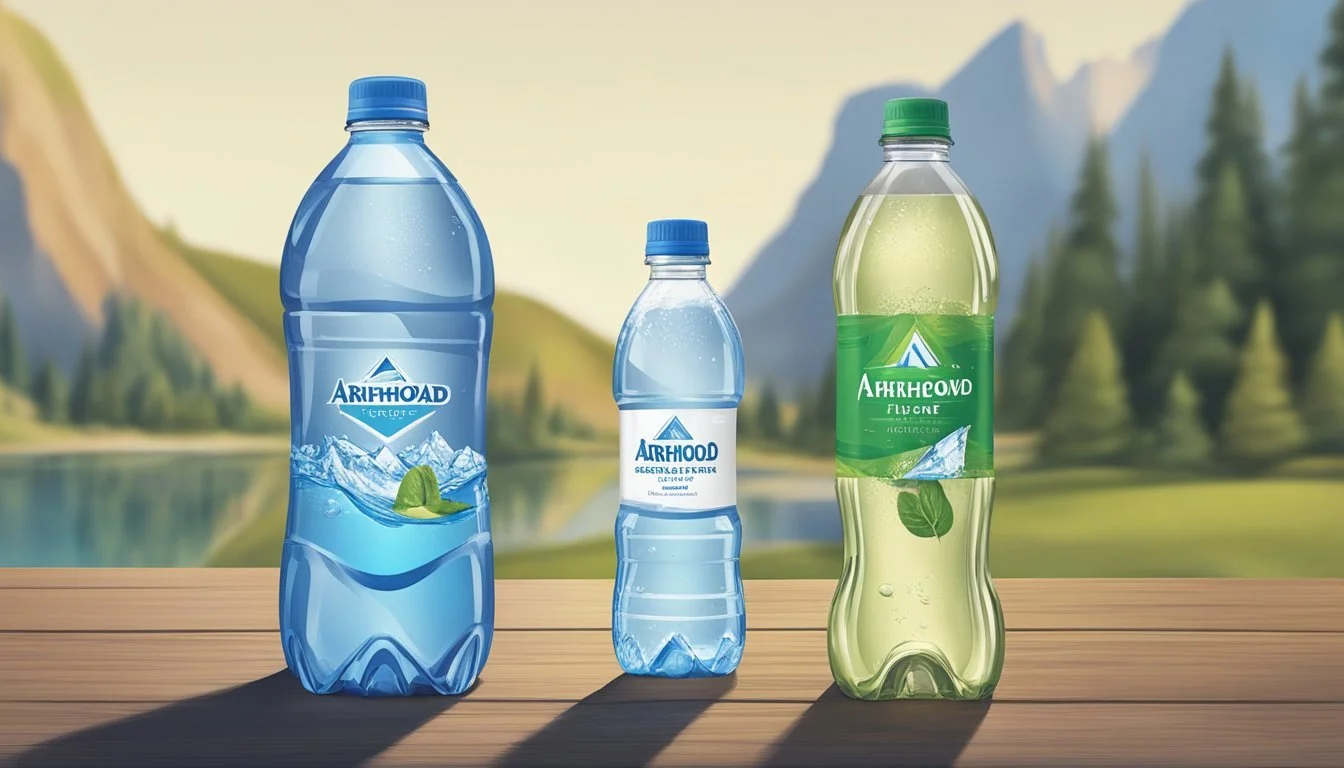Arrowhead vs. Ethos
Comparing Bottled Water Quality and Taste
In the world of bottled water, consumers are often presented with an array of options, each claiming to offer a unique drinking experience. Brands like Arrowhead and Ethos represent distinct choices within this landscape. Arrowhead, a brand that has been around for quite some time, touts its product as mountain spring water sourced from various springs in the western regions of the United States and Canada. It's a familiar name to many, often associated with accessibility and affordability.
Ethos Water, on the other hand, distinguishes itself with a mission that extends beyond hydration. For every bottle sold, Ethos contributes a portion of the proceeds to support water, sanitation, and hygiene education programs in water-stressed countries. This social enterprise model adds a philanthropic angle to the consumer's choice, making Ethos not just a bottled water brand but also a statement of support for global water initiatives.
When debating between Arrowhead and Ethos, consumers are weighing more than taste and price; they are also considering the source of the water and the impact of their purchase. Arrowhead's spring water is pitched against Ethos' model of 'water with a conscience,' presenting a choice between a traditional, well-established brand and one that seeks to marry commerce with social responsibility.
Overview of Bottled Water Industry
The bottled water industry represents a significant segment of the global beverage market, thriving on the consumer demand for convenient and perceived pure drinking options. Bottled water can be found ubiquitously in grocery stores, vending machines, and conveniences outlets, offering a portable and typically safe alternative to tap water. Various water brands compete in this arena, each touting their distinct sources and filtration methods.
Several entities regulate the bottled water industry, ensuring quality and safety standards are met. In the United States, the Environmental Protection Agency (EPA) regulates tap water, while the Food and Drug Administration (FDA) oversees bottled water standards. These regulations help maintain consumer trust in bottled water safety and quality.
Bottled water brands such as Nestlé's Arrowhead have become household names, often emphasizing their natural springs' sources. These brands cater to an increasingly health-conscious consumer base that prioritizes hydration and purity in their choice of beverage.
Despite its convenience, the industry faces scrutiny over environmental concerns, including the use of plastics and the sustainability of water sources. Consumers and regulatory bodies push for practices that mitigate environmental impact, aligning the convenience of bottled water with eco-conscious values.
Arrowhead Water Deep Dive
Arrowhead Mountain Spring Water is a brand known for sourcing its water from mountain springs across the western United States, including places like California's San Bernardino National Forest. This section uncovers Arrowhead's source and origin, evaluates its taste and quality, assesses the environmental impact, and reviews the health and safety regulations governing the product.
Source and Origin
Arrowhead Mountain Spring Water is primarily sourced from 13 different springs in western U.S. locations such as California, Colorado, and Canada. Notably, a significant source is located in the San Bernardino National Forest. The company asserts that each bottle of Arrowhead spring water comes from a natural spring and is collected at the source.
Flavor and Quality Assessment
Water Taste: Arrowhead's Mountain Spring Water has a neutral profile, often described as refreshing and crisp. Flavor additives are not present in their standard spring water, ensuring a pure taste experience that some liken to the freshness of tap water without the chlorination.
Quality: The water undergoes natural filtration through the mountain aquifers, which might contribute to its distinctive taste. Furthermore, the brand touts adherence to rigorous quality control measures, although it has been critiqued for being rather unremarkable compared to other premium brands.
Environmental Impact
Ecosystem: Allegations have surfaced concerning Arrowhead's impact on local ecosystems, particularly the watershed in the San Bernardino National Forest. Environmentalists have raised concerns that bottling water in regions like the Desert Sun could disturbs local fish species and the wider ecosystem.
Carbon Emissions and Plastic Waste: As with the broader bottled water industry, Arrowhead's use of plastic contributes to global plastic waste and carbon emissions. Despite this, the brand is making efforts to reduce its environmental footprint through initiatives like increasing the recycled content in its bottles.
Health and Safety Regulations
EPA and Safe Drinking Water: Arrowhead complies with the Environmental Protection Agency's (EPA) standards, abiding by the Safe Drinking Water Act. This ensures that the water marketed is safe for human consumption and free from contaminants beyond allowable limits, like arsenic.
Disinfection Processes: To ensure safety, the water is subjected to disinfection processes that eliminate potential harmful microbes without altering the flavor.
Permits and Compliance: The company holds appropriate permits for water extraction and consistently reports its compliance with health regulations to maintain public confidence in the safety of its product.
Ethos Water Analysis
Ethos Water has garnered attention for its commitment to social causes, its taste, and the impact on the environment. This analysis section will explore the company's ethos and its environmental policies, as well as provide an assessment of the water's taste and purity.
Company Ethos and Commitment
Ethos Water positions itself as a brand committed to helping children get access to clean water. A portion of its sales is directed towards global humanitarian water programs. Their mission, beyond providing bottled water, includes a focus on social responsibility. They actively market this aspect, engaging consumers who are interested not only in the product but also in contributing to a larger cause.
Taste Profile and Purity
The taste of Ethos Water is described by many as neutral and clean, which aligns with consumer expectations for bottled water. It is a purified water, meaning that the water has been filtered through multi-step purification processes to remove impurities and contaminants. The company ensures that its water meets or exceeds industry standards for purity.
Sustainability and Environmental Policies
Ethos Water faces scrutiny from environmentalists concerned with the use of plastic bottles and the sourcing of water. The brand has responded to these concerns with promises of reducing carbon emissions in their production processes and improving the recyclability of their bottles. Additionally, they have faced criticism for sourcing water from areas affected by droughts, which raises questions about the sustainability of their operations amidst climate change challenges.
Ethos Water, while primarily known for its philanthropic angle, is also working to improve its environmental footprint as public awareness and expectations around sustainability continue to grow.
Comparison of Water Characteristics
In examining Arrowhead and Ethos bottled water, focus centers on the mineral content and the results of comparative taste tests, as these characteristics greatly influence consumer preference and perception.
Mineral Content and Benefits
Arrowhead typically sources its water from natural spring water locations across the western United States and Canada. Natural spring water usually offers a distinct mineral profile depending on the geological source. Common minerals in natural spring water can include calcium, magnesium, potassium, and trace amounts of sodium, which are beneficial for hydration and may contribute small amounts to daily mineral intake.
Ethos Water, on the other hand, stands out for its charitable business model rather than its mineral content. While Ethos is purified and thus contains fewer minerals, part of its sales proceeds goes towards global water programs to help children get access to clean drinking water. This social good does not necessarily contribute to the water's flavor or mineral benefits, but it does impact consumer choice.
Comparative Taste Test
In terms of water taste, preference is subjective and can vary greatly among individuals, including water sommeliers who specialize in the flavor nuances of water.
Arrowhead, according to the given data snippet, does not seem to inspire with its flavor profile, being characterized as "wholly uninspiring." The mountain spring water heritage of Arrowhead could imply a unique taste associated with its natural source, yet this does not necessarily guarantee preference in blind taste tests.
Ethos Water, being purified, may have a neutral taste profile compared to Arrowhead, with no strong mineral flavors. Purified water generally has a clean, pure taste because it undergoes filtration processes that remove most minerals and impurities. This could make the water flavor less distinctive, yet potentially more appealing to those who prefer a neutral taste.
In conclusion, the water characteristics between Arrowhead and Ethos vary significantly, from the mineral-rich profile of Arrowhead's natural spring water to the socially-conscious, purified offering of Ethos. Preference in taste is a personal matter that can sway consumers towards one brand or the other.
Market Presence and Consumer Preferences
Bottled water brands like Arrowhead and Ethos Water captivate different segments of the market through targeted branding and widespread distribution.
Branding and Marketing Strategies
Arrowhead utilizes its long history and regional appeal, positioning itself as a provider of mountain spring water from various sources in the western United States and Canada. The brand's marketing often highlights the natural origin of its water, aiming to attract consumers who value tradition and the image of purity.
Alternatively, Ethos Water presents itself with a socially responsible image, promising that their sales contribute to humanitarian water programs. This brand's strategy appeals to a consumer base that prioritizes ethical consumption and the well-being of global communities.
Availability and Accessibility
Arrowhead is a mass-produced brand, widely available in numerous retail settings, from small convenience stores to large grocery chains. Here is a quick look at Arrowhead's availability:
Convenience Stores: Commonly found; offers ease of purchase for consumers on the go.
Grocery Stores: Regularly stocked; often positioned in high-traffic areas for visibility.
Ethos Water, while also available in grocery stores, is notably associated with Starbucks, which significantly enhances its visibility and availability to consumers seeking premium products with a cause. The strategic placement in a popular coffee chain underscores its market reach:
Starbucks: Primary retail partner; accessible in locations worldwide.
Grocery Stores: Available; placement strategy may be more selective than Arrowhead's.
Packaging and Design Considerations
In the bottled water industry, packaging design is not just about aesthetics; it significantly impacts brand recognition and environmental sustainability. Consumers and environmentalists alike scrutinize the materials and design choices brands make.
Bottle Materials and Environmental Concerns
Arrowhead uses plastic bottles, a common choice for many brands due to their cost-effectiveness and lightweight nature. However, plastic bottles contribute to environmental concerns such as increasing plastic waste, ecosystem damage, and carbon emissions. Ethos Water, on the other hand, aligns its packaging strategy with its humanitarian message. Although Ethos also uses plastic bottles, the brand’s commitment to social causes is evident in its donations towards clean water initiatives. Sustainability enthusiasts are urging bottled water companies to reduce their carbon footprint and explore alternative packaging solutions, such as using recycled plastic or alternative materials like boxed water to mitigate climate change impacts.
Label Design and Brand Recognition
The label design of Arrowhead is straightforward and leverages the image of mountain springs to emphasize the purity of the water. This practice is quite common in the industry and aims to enhance brand recall. Ethos Water's label design incorporates its social mission, which also serves as a tool for marketing its cause. The inclusion of the message concerning donations on the Ethos label boosts brand recognition and appeals to consumers who value corporate social responsibility. Environmentalists often critique brands for not emphasizing environmental information on labels to promote sustainable practices among consumers.
Legal and Ethical Practices
In the realm of bottled water, the utilization of water sources and adherence to consumer safety regulations are critical considerations for both Arrowhead and Ethos Water. These concerns are pivotal when addressing the legal and ethical practices employed by bottled water companies.
Water Rights and Source Issues
Arrowhead has faced scrutiny for its water-bottling operations in the San Bernardino National Forest, with allegations of extracting groundwater without proper rights and impacting the local watershed. Environmental groups have contended that the longstanding practice could potentially threaten the health of the forest's ecosystem, affecting its flora and fauna. Ethos Water, conversely, is known for its commitment to ethical sourcing and contributions to global water projects, although its association with parent company Starbucks and resource use also warrant consumer consideration.
Arrowhead:
Accusations of improper groundwater extraction in San Bernardino National Forest
Disputes over the impact on local ecosystems and watersheds
Ethos Water:
Emphasizes ethical water sourcing
Associated with global charitable water initiatives
Consumer Safety and Regulation Adherence
When comparing Arrowhead to Ethos, consumer safety and the observance of regulations are paramount. Arrowhead, like all bottled water in the United States, must conform to the EPA's safety standards regarding safe drinking water, including standards for contaminants like arsenic. Disinfection and assurance against pathogens are also integral to maintaining health standards for bottled water. Ethos Water follows the same regulations, with both brands providing a warranty of safety to consumers.
Safety Standards Compliance:
EPA guidelines for contaminants and disinfection processes
Warranty for safe drinking water upheld by both brands
Consumer Health:
Monitoring for arsenic and other potential health risks
Regular testing to ensure the water meets or exceeds safety regulations
Cost and Economic Considerations
When comparing Arrowhead and Ethos bottled water, consumers often consider price and accessibility as significant factors. Arrowhead, a brand recognized for its mountain spring water, tends to offer an economic choice that's readily available in most grocery stores and outlets. Its cost-effectiveness makes it a go-to for consumers looking for hydration without a high price tag.
Ethos Water, on the other hand, positions itself in a different segment of the market. While typically more expensive than Arrowhead, Ethos differentiates itself by pledging to help children get clean water with every bottle purchased. The brand often occupies shelf space in premium stores and is also frequently found in Starbucks, highlighting its convenience but with a higher cost.
Below is a brief comparison of the two brands:
Aspect Arrowhead Ethos Price Point Economical Premium Availability Wide Selected Outlets Convenience High Moderate Social Impact Standard Charity-Driven
Both brands maintain a presence in grocery store chains, providing consumer access across different economic backgrounds. Ethos’ philanthropic angle might appeal to consumers who value social responsibility with their purchases, while Arrowhead meets the needs of those prioritizing cost savings. Each water brand's economic considerations extend beyond the shelf price, encompassing ethical spending and availability to the consumer, which influence purchasing decisions in different ways.
Public and Expert Opinions
In this section, the opinions of both the general public and experts regarding Arrowhead and Ethos bottled waters are explored. This covers perceptions on taste and quality as well as the environmental impact each brand has.
Reviews and Recommendations
Arrowhead has received mixed reviews on taste, with some users finding it "wholly uninspiring". In contrast, Ethos Water often garners appreciation for its taste, although it is less commonly found. Neither brand consistently tops the list in water taste tests, but Ethos is sometimes highlighted for its richness and refreshment.
Experts like water sommeliers, though a niche profession, provide a unique perspective, placing a high value on taste and origin. However, their exhaustive knowledge often leads them to recommend more specialized or lesser-known brands over Arrowhead or Ethos.
Environmental Advocacy and Criticism
Environmentalists commonly critique bottled water brands for their contribution to plastic waste and carbon emissions. Arrowhead, sourced from mountain springs, faces backlash over the potential impact on local ecosystems. Ethos Water positions itself differently by pledging to help children get clean water, demonstrating a socially responsible ethos.
However, despite these good intentions, both brands are part of an industry which is under scrutiny for not doing enough to offset the environmental cost of single-use plastic bottles. The discussion often centers on the need for better recycling infrastructure and more eco-friendly packaging alternatives to minimize impact.
Conclusion: The Verdict on Arrowhead vs. Ethos Water
When comparing Arrowhead and Ethos bottled waters, consumers typically weigh several factors, including the source of the water, taste, safety, environmental impact, and ethical considerations.
Arrowhead:
Sourced from the San Bernardino Mountains, Arrowhead is marketed as 100% Mountain Spring Water. It has faced scrutiny over water rights and environmental impact, notably in California where concerns have been raised about the sustainability of sourcing practices.
Ethos Water:
Ethos Water stands out for its commitment to ethical practices. A portion of its profits supports water projects in developing countries, aiming to provide safe drinking water. Ethos is filtered and has a more predictable mineral profile due to its varied sources versus mountain springs.
Environmental Impact & Ethical Concerns:
Ethos takes a clear lead in ethical concerns by supporting water access initiatives. Arrowhead's local impact has been contentious, drawing legal challenges and environmental criticism.
Taste & Flavors:
While Arrowhead offers the natural minerals and taste of mountain spring water, Ethos provides a consistent flavor due to its processing. The choice between natural spring or purified water boils down to personal preference.
Safety:
Both brands meet FDA regulations for safe drinking water. However, Ethos' philanthropic mission adds a layer of social responsibility to its brand.
The Consumer's Decision:
Buyers looking for a traditional spring water experience may prefer Arrowhead. Those prioritizing social impact and a more controlled mineral taste may lean towards Ethos. It's important for consumers to consider both personal taste and the broader implications of their purchase.








